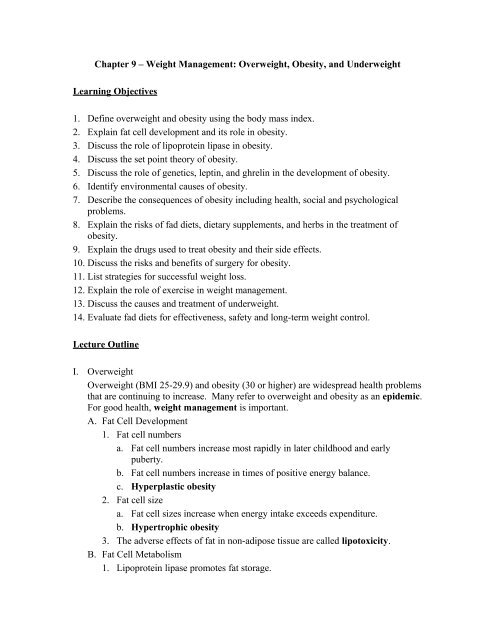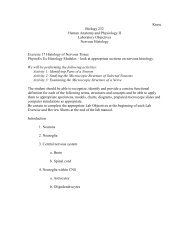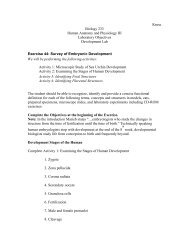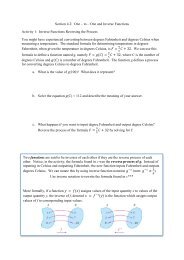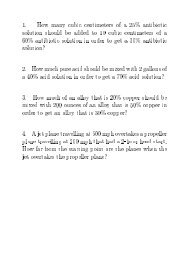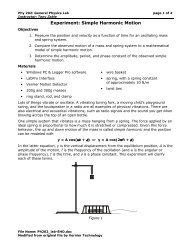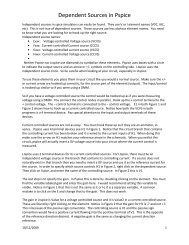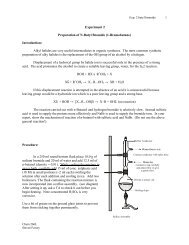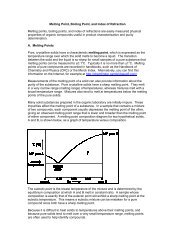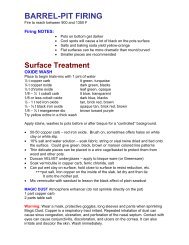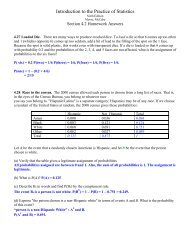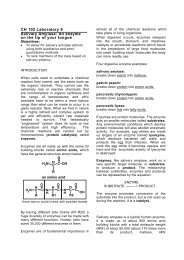Chapter 9 – Weight Management: Overweight, Obesity, and ... - PCC
Chapter 9 – Weight Management: Overweight, Obesity, and ... - PCC
Chapter 9 – Weight Management: Overweight, Obesity, and ... - PCC
You also want an ePaper? Increase the reach of your titles
YUMPU automatically turns print PDFs into web optimized ePapers that Google loves.
<strong>Chapter</strong> 9 <strong>–</strong> <strong>Weight</strong> <strong>Management</strong>: <strong>Overweight</strong>, <strong>Obesity</strong>, <strong>and</strong> Underweight<br />
Learning Objectives<br />
1. Define overweight <strong>and</strong> obesity using the body mass index.<br />
2. Explain fat cell development <strong>and</strong> its role in obesity.<br />
3. Discuss the role of lipoprotein lipase in obesity.<br />
4. Discuss the set point theory of obesity.<br />
5. Discuss the role of genetics, leptin, <strong>and</strong> ghrelin in the development of obesity.<br />
6. Identify environmental causes of obesity.<br />
7. Describe the consequences of obesity including health, social <strong>and</strong> psychological<br />
problems.<br />
8. Explain the risks of fad diets, dietary supplements, <strong>and</strong> herbs in the treatment of<br />
obesity.<br />
9. Explain the drugs used to treat obesity <strong>and</strong> their side effects.<br />
10. Discuss the risks <strong>and</strong> benefits of surgery for obesity.<br />
11. List strategies for successful weight loss.<br />
12. Explain the role of exercise in weight management.<br />
13. Discuss the causes <strong>and</strong> treatment of underweight.<br />
14. Evaluate fad diets for effectiveness, safety <strong>and</strong> long-term weight control.<br />
Lecture Outline<br />
I. <strong>Overweight</strong><br />
<strong>Overweight</strong> (BMI 25-29.9) <strong>and</strong> obesity (30 or higher) are widespread health problems<br />
that are continuing to increase. Many refer to overweight <strong>and</strong> obesity as an epidemic.<br />
For good health, weight management is important.<br />
A. Fat Cell Development<br />
1. Fat cell numbers<br />
a. Fat cell numbers increase most rapidly in later childhood <strong>and</strong> early<br />
puberty.<br />
b. Fat cell numbers increase in times of positive energy balance.<br />
c. Hyperplastic obesity<br />
2. Fat cell size<br />
a. Fat cell sizes increase when energy intake exceeds expenditure.<br />
b. Hypertrophic obesity<br />
3. The adverse effects of fat in non-adipose tissue are called lipotoxicity.<br />
B. Fat Cell Metabolism<br />
1. Lipoprotein lipase promotes fat storage.
2. Gender differences<br />
a. Men are at increased risk for developing central obesity <strong>and</strong> women are at<br />
increased risk for lower body fat.<br />
b. Enzymes that break down fats affect men <strong>and</strong> women differently.<br />
C. Set-Point Theory<br />
1. The body’s natural regulatory centers maintain homeostasis at set point.<br />
2. The human body tends to maintain a certain weight.<br />
II. Causes of <strong>Obesity</strong><br />
<strong>Obesity</strong> may not be as simple as food intake exceeding metabolic needs. Some<br />
factors, such as overeating <strong>and</strong> inactivity, are within our control. Genetic, hormonal<br />
<strong>and</strong> emotional factors may require professional intervention.<br />
A. Genetics: heredity is the most important factor that determines the risk of obesity<br />
1. Leptin (also called the ob protein)<br />
a. Protein that acts as a hormone to increase energy expenditure <strong>and</strong> decrease<br />
appetite<br />
b. Produced by fat cells under the direction of the ob gene<br />
c. May be deficient in obese individuals<br />
d. Injections of leptin are effective only when obesity is caused by leptin<br />
deficiency.<br />
2. Ghrelin<br />
a. Protein that acts as a hormone to stimulate the appetite <strong>and</strong> promote<br />
energy storage.<br />
b. Secreted by stomach cells<br />
c. When PYY levels are elevated ghrelin levels decrease. PYYdecreases<br />
food intake <strong>and</strong> may be an effective treatment for obesity.<br />
3. Uncoupling Proteins<br />
a. Influence energy metabolism<br />
b. White adipose tissue stores fat to be used for energy.<br />
c. Brown adipose tissue stores fat to be used for heat.<br />
d. May oppose the development of obesity<br />
B. Environment <strong>–</strong> The gene pool of our population remains relatively unchanged.<br />
1. Overeating<br />
a. Present <strong>and</strong> past eating influences current body weight.<br />
b. Increased availability of convenient food, large portions, <strong>and</strong> energy-dense<br />
foods<br />
2. Physical Inactivity<br />
a. Modern technology replaces physical activities.
. Physical activity is important to allow people to eat enough food to get<br />
needed nutrients.<br />
III. Problems with <strong>Obesity</strong><br />
<strong>Obesity</strong> problems depend on many factors such as the extent of overweight, age,<br />
health status <strong>and</strong> genetic makeup. Risk factors may differ among individuals.<br />
A. Health risks are evaluated using BMI, waist circumference <strong>and</strong> disease profiles.<br />
1. <strong>Overweight</strong> people who are in good health may not need to lose weight.<br />
2. Obese or overweight people with risk factors could improve health by losing<br />
weight or using other diet <strong>and</strong> exercise strategies. Risk factors include:<br />
a. Hypertension<br />
b. Cigarette smoking<br />
c. High LDL<br />
d. Low HDL<br />
e. Impaired glucose tolerance<br />
f. Family history of heart disease<br />
g. Men 45 years <strong>and</strong> older, women 55 years <strong>and</strong> older<br />
3. Obese or overweight people with the following life-threatening-conditions<br />
may improve health by losing weight:<br />
a. Heart disease<br />
b. Type 2 diabetes<br />
c. Sleep apnea<br />
B. Perceptions <strong>and</strong> Prejudices<br />
1. Social Consequences<br />
a. Prejudices <strong>and</strong> discrimination<br />
b. Judged on appearance rather than character<br />
c. Stereotyped as lazy <strong>and</strong> lacking self-control<br />
2. Psychological Problems<br />
a. Feelings of rejection, shame <strong>and</strong> depression are common.<br />
b. Ineffective treatments can lead to a sense of failure.<br />
C. Dangerous Interventions<br />
1. Fad Diets<br />
a. False theories<br />
b. Inadequate diets<br />
c. Can be a danger to health<br />
2. <strong>Weight</strong>-Loss Products<br />
a. Ephedrine-containing products inhibit serotonin <strong>and</strong> suppress the<br />
appetite. Supplements containing Ephedra have been banned by the FDA<br />
due to potential health risks.
. Herbal laxatives do not prevent absorption.<br />
c. Current laws do not require safety tests <strong>and</strong> effectiveness tests for these<br />
products.<br />
3. Other Gimmicks<br />
a. Hot baths, steam <strong>and</strong> saunas have no impact on fat loss.<br />
b. There is no such thing as cellulite.<br />
IV. Aggressive Treatments of <strong>Obesity</strong><br />
Individuals with clinically severe obesity <strong>and</strong> major medical problems may benefit<br />
from drugs or bariatric surgery. But changing <strong>and</strong> improving eating <strong>and</strong> exercise<br />
habits offer the greatest benefit.<br />
A. Drugs<br />
1. Sibutramine suppresses the appetite <strong>and</strong> is most effective when used with a<br />
reduced kcalorie diet <strong>and</strong> increased physical activity. There are many side<br />
effects.<br />
2. Orlistat blocks fat digestion <strong>and</strong> absorption. There are many side effects.<br />
3. Phentermine <strong>and</strong> diethypropion enhance the release of norepinephrine<br />
resulting in elevated blood pressure <strong>and</strong> insomnia.<br />
B. Surgery<br />
1. Surgery is an option for those who have tried weight loss programs <strong>and</strong> failed,<br />
have a BMI greater than or equal to 35, <strong>and</strong> are having health problems due to<br />
their weight.<br />
2. Gastric surgery has short-term <strong>and</strong> long-term problems <strong>and</strong> requires<br />
compliance with dietary instructions.<br />
3. Liposuction is a popular procedure that is primarily cosmetic but poses risk.<br />
V. <strong>Weight</strong>-Loss Strategies<br />
A life-long eating plan for good health, which includes nutritionally adequate eating,<br />
reasonable expectations, regular physical activity, <strong>and</strong> permanent lifestyle changes, is<br />
best for achieving permanent weight loss. <strong>Weight</strong> loss of 1-2 pounds per week or<br />
10% of body weight in six months is safe.<br />
A. Eating Plans<br />
1. Be Realistic about Energy Intake<br />
a. 300-500 kcalories/day reduction for BMI between 27 <strong>and</strong> 35<br />
b. 500-1000 kcalories/day reduction for BMI greater than or equal to 35<br />
c. Dietary Guidelines should be followed.<br />
2. Diet should be nutritionally adequate while avoiding excessive consumption.<br />
3. Smaller portions are recommended to feel satisfied, not stuffed.<br />
4. Eat foods of lower energy density that are high in fiber, high in water <strong>and</strong> low<br />
in fat.<br />
5. Water is important to increase fullness <strong>and</strong> reduce hunger.
6. Complex carbohydrates offer abundant vitamins, minerals <strong>and</strong> fiber with little<br />
fat.<br />
7. Choose fats sensibly <strong>and</strong> reduce the quantity of fat.<br />
8. Watch empty kcalories from sugar <strong>and</strong> alcohol.<br />
9. Artificial sweeteners will not lower energy intake if high Kcalorie food are<br />
consumed.<br />
B. Physical Activity<br />
1. An individual’s body weight as well as intensity <strong>and</strong> duration of activity<br />
influence energy expenditure.<br />
2. Physical activity increases the amount of discretionary kcalories that can be<br />
consumed.<br />
3. Metabolic rates can rise with daily vigorous activity.<br />
4. Activity can decrease body fat <strong>and</strong> increase lean body mass.<br />
5. Exercise may help to curb appetite.<br />
6. Activity can reduce stress <strong>and</strong> improve self-esteem.<br />
7. Choosing Activities<br />
a. Choose activities that you enjoy <strong>and</strong> are willing to do regularly.<br />
b. Low to moderate intensity for long duration is recommended.<br />
c. Daily routines can incorporate energy activities.<br />
8. Spot Reducing<br />
a. Regular aerobic exercise <strong>and</strong> weight loss will help trouble spots.<br />
b. Strength training can improve muscle tone.<br />
c. Stretching can help flexibility.<br />
Environmental influences<br />
1. Lighting, décor, aromas, <strong>and</strong> sounds can influence intake/<br />
2. Accessibility, ease, <strong>and</strong> convenience of food influence how much is<br />
consumed.<br />
3. Social events <strong>and</strong> interactions can lead to increased intake.<br />
4. Being distracted which eating can lead to an increased intake.<br />
5. The presence of food can lead someone to eat even if they are not hungry.<br />
6. Seeing an assortment of food can lead people to eat too much.<br />
7. Large portion sizes lead t overeating.<br />
8. The sized of a plate or bowl can lead t eating too much.<br />
C. Behavior <strong>and</strong> Attitude<br />
1. Behavior modification requires time <strong>and</strong> effort.
2. Awareness of behavior is the first key.<br />
3. Changing behaviors one at a time works best.<br />
a. Do not grocery shop when hungry.<br />
b. Eat slowly.<br />
c. Exercise while watching television.<br />
4. Personal attitudes toward food <strong>and</strong> eating must be understood.<br />
5. Support groups may be helpful for some people.<br />
D. <strong>Weight</strong> Maintenance<br />
1. Successful weight-loss maintenance programs use different criteria so they<br />
are difficult to compare.<br />
2. Vigorous exercise <strong>and</strong> careful eating plans are key.<br />
3. Frequent self-monitoring is recommended.<br />
E. Prevention<br />
1. Eat regular meals <strong>and</strong> limit snacking.<br />
2. Drink water in place of high-kcalorie beverages.<br />
3. Select sensible portion sizes <strong>and</strong> limit daily energy intake to energy expended.<br />
4. Limit sedentary activities <strong>and</strong> be physically active.<br />
F. Public health programs have been suggested to:<br />
1. Develop safety st<strong>and</strong>ards for foods.<br />
2. Control commercial advertising.<br />
3. Control conditions under which foods are sold.<br />
4. Control prices to reduce consumption.<br />
VI. Underweight (BMI < 18.5)<br />
Incidences of underweight <strong>and</strong> associated health problems are less prevalent than<br />
overweight <strong>and</strong> obesity problems.<br />
A. Problems of Underweight<br />
1. Causes are diverse.<br />
2. Energy dem<strong>and</strong>s may be great <strong>and</strong> foods are needed to support growth <strong>and</strong><br />
physical activities.<br />
3. Eating disorders are severe cases.<br />
B. <strong>Weight</strong>-Gain Strategies<br />
1. Energy-dense foods can be included but choose fat wisely to avoid the<br />
associated cardiac risks.<br />
2. Regular meals each day must become a priority.<br />
3. Use large portions <strong>and</strong> expect to feel full.<br />
4. Consume extra snacks between meals.<br />
5. Juice <strong>and</strong> milk are easy ways to increase kcalories.<br />
6. Exercising to build muscles will support increases in muscle mass.
VII. Highlight 9The Latest <strong>and</strong> Greatest <strong>Weight</strong>-Loss Diet Again<br />
Fad diets do not offer safe or effective plans for weight loss. Diet<br />
recommendations should be research based. There are guidelines for identifying<br />
fad diets <strong>and</strong> weight-loss scams.<br />
A. The Diet’s Appeal<br />
1. There are many misconceptions <strong>and</strong> distortions of facts.<br />
2. Results are not long lasting.<br />
B. The Diet’s Achievements<br />
1. Don’t Count kCalories<br />
2. Satisfy Hunger<br />
3. Follow a Plan<br />
4. Limit Choices<br />
C. The Diet’s Shortcomings<br />
1. Too Much Fat<br />
2. Too Much Protein<br />
3. Too Little of Everything Else<br />
D. The Body’s Perspective <strong>–</strong> Adverse side effects of low-carbohydrate, ketogenic<br />
diets<br />
1. Nausea<br />
2. Fatigue<br />
3. Constipation<br />
4. Low blood pressure<br />
5. Elevated uric acid<br />
6. Stale, foul taste in the mouth<br />
7. Fetal harm <strong>and</strong> stillbirth


